These notes are intended to provide a casual sky watcher or someone already into amateur astronomy living in Eastern Australia with a summary of what is happening in the night sky in June 2013. The finder charts have been produced for an observer based in Brisbane (Queensland, Australia) but will be useful for observers elsewhere in Eastern Australia.
Instructions on how to obtain customised satellite viewing information for your location can be found here. If you find this page of interest, you may wish to follow this website automatically using Twitter and the sites RSS Feed.
Planets for June 2013
Mercury and Venus are visible low above the Western horizon as evening twilight ends. Saturn is visible above the Northern horizon at the end of evening twilight. Jupiter is briefly visible at the start of the month in the bright evening twilight before it moves close to the Sun and then is invisible to Earth based telescopes until July. Mars is visible in the bright morning twilight sky low above the North Eastern horizon. Neptune rises around 10:30 pm mid-month and Uranus rises just after 1 am mid-month.
Individual sky events (June 2013)
All times AEST unless otherwise stated.
All month: If you are lucky enough to live away from bright street lights, don’t forget to look for the ancient Aboriginal constellation The Emu. Unlike traditional European constellations, Aboriginal constellations can use the dark patches (in reality giant dust clouds drifting in space that obscure light from background stars) in the Milky Way to represent creatures from the Dreamtime. Background information about the Emu can be found at http://www.abc.net.au/science/articles/2009/07/27/2632463.htm#.UaIGsfFqM7y. The head of the Emu is made up of what astronomers refer to as the Coal Sack nebula located in the constellation Crux (more commonly known as the Southern Cross) and the body stretches across the ancient Greek constellation Scorpius and the legs past it. It is an enormous constellation and once you have seen it from a dark sky site, you will wonder why you had never noticed it before. A finder chart can be found at http://astroblogger.blogspot.com.au/2009/07/seeing-emu.html. Note that the real constellation is much more like an emu than that shown in the finder chart.
1 June 2013: 4:58 am Last Quarter Moon
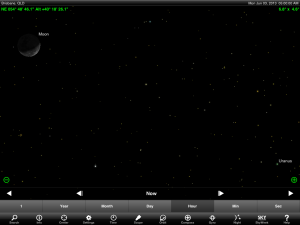
3 June 2013: Waning crescent Moon located to left of and above Uranus. Morning sky. A minimum of a pair of binoculars and a finder chart will be need to locate Uranus. A finder chart for both Neptune and Uranus can be found on the Sky & Telescope website: http://www.skyandtelescope.com/observing/highlights/Uranus-and-Neptune-in-2013-190064991.html
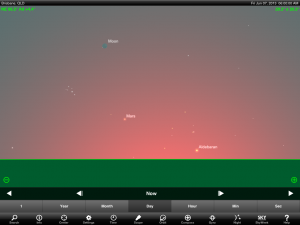
7 June 2013: A slim crescent Moon is located above Mars in the bright morning twilight. Very difficult. Most likely not visible even with optical aid.
8 June 2013: 4 am Neptune stationary
9 June 2013: 1:56 am New Moon
10 June 2013: 8 am Moon at apogee 406,486 km (furthest point from Earth in it’s orbit)
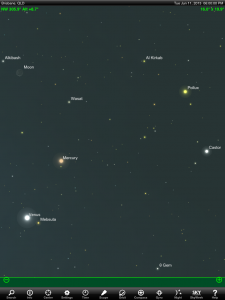
10 – 11 June 2013: Crescent Moon passes to left of Venus and Mercury (evening twilight)
13 June 2013: 3 am Mercury at greatest elongation East (24.3 degrees)
13 June 2013: Venus at perihelion
17 June 2013: 3:24 am First Quarter Moon
18 June 2013: Mercury at descending node
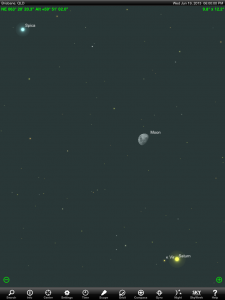
19 June 2013: Gibbous Moon located above Saturn (early evening sky)
20 June 2013: 2 am Jupiter in conjunction with Sun
21 June 2013: 3 pm Winter Solstice
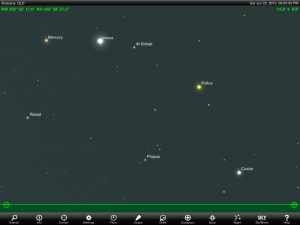
23 June 2013: 6 am Minor planet Vesta 0.2 degrees North of Venus. This won’t be visible as both objects are below our local horizon at the time. However, try looking for Vesta below Venus using binoculars later that evening (see finder chart – below). I don’t know if you will be able to see Vesta given that it is only magnitude +8.3 and it will be very low on the horizon. I have never tried looking for something this faint so low on the horizon. Give it a go and let me know.
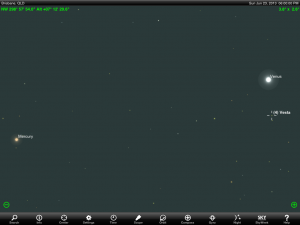
23 June 2013: 9 pm Moon at perigee 356,991 km from Earth in its orbit
23 June 2013: 9:32 pm Full Moon ‘Super Moon’ for year. 34 arc minutes in diameter. The Moon will appear larger than any other Moon of 2013 as June’s Full Moon occurs within 32 minutes of the Moon’s closest approach to the Earth for the year. The reason for the increase in the apparent size of the Moon has to do with the Moon’s egg shaped or elliptical orbit. There is approximately a 50,000 kilometre difference between when the Moon is at its closest (perigee) and it’s furthest from the Earth (what is referred to as apogee). June 2013′s Full Moon will occur at almost the same time as the closest approach of the Moon to the Earth for the year at a mere 356,991 kilometres. For South East Queensland, king tides for 2013 will occur the day after June’s ‘Super’ Moon as the Earth’s oceans respond to the pull of the Moon’s gravity. The next ‘Super’ Moon will occur on 10 August 2014.
26 June 2013: 9 am Mercury stationary
29 June 2013: Mercury at aphelion
30 June 2013: 2:54 pm Last Quarter Moon
For Further Information
Customised Astronomy & Satellite Viewing information
Information on how to obtain customised astronomy & satellite viewing information for your location can be found here on this website.
References
The information in this post has been prepared using the following references.
Astronomy 2013, Quasar Publishing http://www.quasarastronomy.
Sky Safari Pro Ipad app, http://www.southernstars.com/
@Nightskyonline Had some aurora activity earlier tonight. http://t.co/peYDJr3jUR